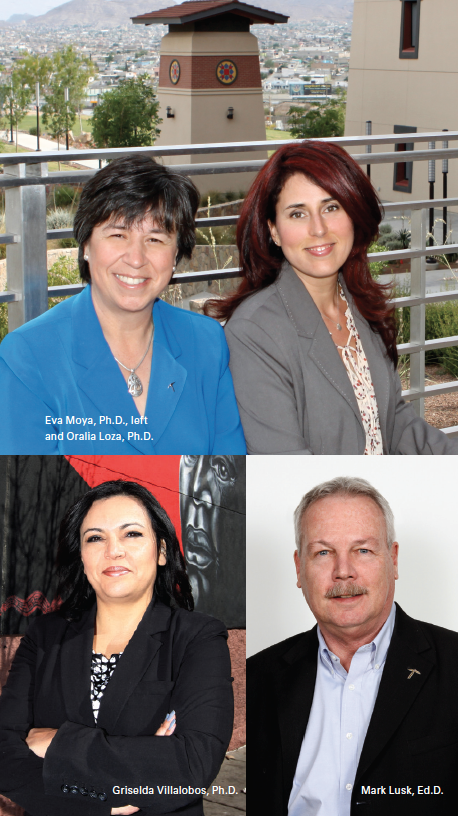They cross from Mexico into the United States in search of a better life for themselves and their families.
They work on construction sites in sweltering temperatures, or bent over in the fields picking cotton, onions and tomatoes. They scrape by on a living that isn’t enough to pay for the houses they build or the crops they pick.
Some live in the shadows, afraid of deportation or discrimination. Others dream of returning home someday.
They are migrants.
The Pew Hispanic Research Center estimates that more than 10 million Mexicans migrated into the United States from Mexico between 1970 and 2010 – one of the largest mass migrations in modern history.
Their journeys are at the heart of research being conducted by UTEP College of Health Sciences faculty members Mark Lusk, Ed.D.; Griselda Villalobos, Ph.D.; Eva Moya, Ph.D.; and Oralia Loza, Ph.D. They are studying how violence, depression, sexual and reproductive health and HIV/AIDS are affecting the emotional and physical wellbeing of migrants living in the United States.
“The global phenomenon of migration impacts social, economic, educational and health systems in both the sending and receiving communities,” said Kathleen Curtis, Ph.D., dean of the College of Health Sciences. “Our unique location and access to people who migrate both to and through our region provide opportunities to identify particular health challenges that these vulnerable populations experience and recommend policy and programmatic solutions to address these issues.”
Drug-related violence in Mexico during the past five years is the backdrop for Lusk’s study on depression and trauma suffered by refugees who have left Northern Mexico and settled in the United States.
Lusk, professor and chair of UTEP’s Department of Social Work, and Villalobos, assistant professor of social work, have interviewed 24 adults since 2010 who fled Mexico because their lives had been permeated by extortion, rape, kidnapping and murder as a result of drug-related violence in Juárez and throughout Mexico.
“I’m not coming at it as a political scientist or as a person who’s attempting to understand the national politics of Mexico, but I’m coming to it as a social worker who’s seeing a city that has been decimated by violence, and a country that’s been decimated by violence, and I look at that entirely in human terms,” said Lusk, the recipient of the 2012 Lifetime Achievement Award from the Rio Grande Chapter of the National Association of Social Workers.
The majority of the participants suffered from clinical depression and anxiety associated with post-traumatic stress disorder, but researchers were surprised to see that most of the individuals showed great resiliency and were coming out of their depression in as little as six months.
“We thought that we were going to find a lot of people who are very depressed or living in the shadows, and what we found is very much the opposite. It is almost like they had to readapt to a new world and they’re just doing the best they can with it,” Villalobos said. “It’s been very inspirational.”
That resiliency is also one of the characteristics exhibited by the migrant workers Villalobos interviewed for her study on depression and mental health.
In conjunction with the Universidad de Guadalajara, researchers interviewed 93 men in the United States and 104 men in Mexico about their emotional state while living and working in the U.S.
Villalobos found that the nine classic symptoms that are used to measure anxiety and depression, such as lack of energy or concentration, do not apply to migrant workers because of their lifestyle.
According to Curtis, estimates indicate that as many as 1.8 million people migrate annually to the United States.
The Pew Hispanic Research Center found that Mexican migrant women are becoming the largest and fastest-growing migrant group in the U.S., making their sexual and reproductive health and access to family planning and reproductive health services critical.
In March, Moya, assistant professor of social work, and partners at the Universidad de Guadalajara and a Jalisco-based agency that promotes women’s reproductive health, launched a 12-month study that looks at “The Sexual and Reproductive Health of Mexican Migrant Women in Ciudad Juárez, Guadalajara, Mexico, and El Paso, Texas.”
“The results of this study will provide a better understanding of migrant women’s health needs and access to reproductive care, which will help shape public policy to improve sexual and reproductive health access and address the social determinants that influence migrant women’s health-seeking behaviors,” Moya said.
Loza’s project addresses risks for HIV/AIDS and sexually transmitted infections among Mixtec/Zapotec men who migrate within Mexico and to the U.S.
A 2004 study found that 33 percent of AIDS victims in Mexico were migrants.
Loza, an assistant professor of public health sciences, and partners from Universidad Autonoma de Chihuahua, are looking at the perception, attitudes and behaviors toward HIV/AIDS of the male population in two groups indigenous to Oaxaca, Mexico.
“We need to tailor HIV prevention to the different communities,” Loza said. “What works in one population to help reduce HIV doesn’t work in all populations. So you have to understand how people think and how they behave when it comes to HIV risk.”
The studies by Villalobos, Moya and Loza are funded by the Programa de Investigacion de Migracion y Salud (PIMSA), an initiative of the University of California Office of the President that involves a broad consortium of universities and governmental organizations in the United States and Mexico that conduct research on migration and health.
The results of this research are used to drive regional health planning and strategic interventions to address the needs of migrating populations in our communities, Curtis said.